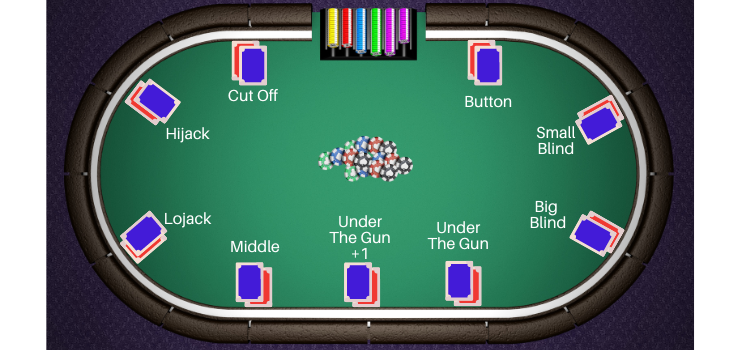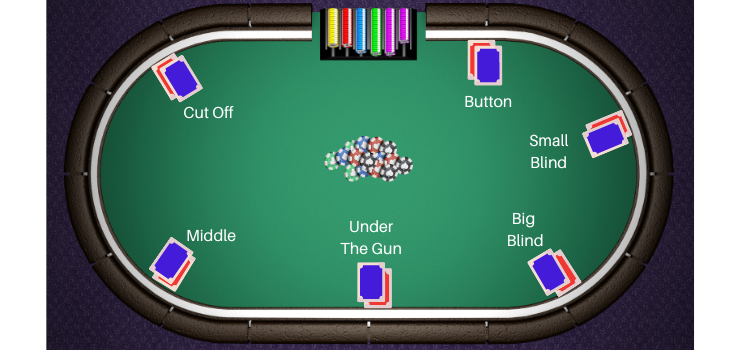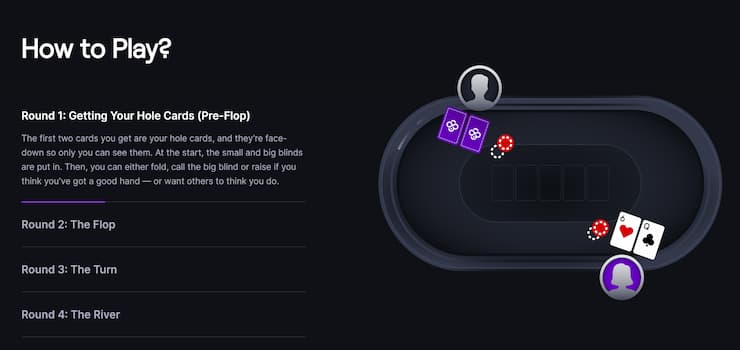After learning the rules and hand rankings, the next thing a future poker pro must master is poker positions. These positions impact the game’s flow, like in Texas Hold’em, where the different blinds are governed by the positions at the table, so every player needs to learn each position.
This is precisely what we’ll cover in detail in this comprehensive guide on all 6-handed and 9-handed poker positions. We’ll explain and give answers to some burning questions, so ante up and dive into this poker strategy guide.
What Are the Best Poker Positions When Playing Texas Hold’em?
Poker table positions can be challenging to understand, and even more difficult to master when starting with the most popular form of poker, Texas Hold’em. The same goes for Omaha and any other type of poker.
To make it easier, we’ve prepared a range of images and explanations covering various positions in poker and which ones are higher up in the game’s hierarchy. We’ll explain every essential position in the paragraphs below and tell when it’s used in 9-handed or 6-handed poker table formats.
The Button (Dealer)
The poker button position is the game’s dealer in every format and typically has a white button in front of them, hence the name. The BTN (button) is often considered the best position to be in, as you get to see what the first three positions will do so you can adjust your poker strategy accordingly.
More than that, as the initial poker table position in the game, you’re also the last to act after the flop. The BTN has the widest RFI (raise first in) range of 48%, meaning you have the potential for the most hands to play.
The Small Blind
The Small Blind (SB) is the position in poker that plays straight after the button and is occupied by the player sitting to the left of them. This gives the player the privilege of seeing what others do before them, but it’s still not a very good position, as you have to act immediately after the flop.
The SB’s RFI is narrower than the BTN’s, sitting at 36%. Another disadvantage of this position is having to put chips in the pot before seeing your hole cards. This is the same for all poker formats.
The Big Blind
The Big Blind position comes after the small blind and is the one that has to put the big blind in, i.e., double the money put up by SB. Again It exists in both formats.
This is generally considered the worst position in poker, as you can’t see your cards and must put the most money in initially. On top of that, you are the second player to act after the flop.
Under the Gun
Under the Gun is the player coming after the Big Blind in a typical poker table order. It’s also one of the least favorable positions overall and the worst position preflop because you have the least info on which to act, i.e., only your cards. It exists in both 9-handed and 6-handed poker.
With only your cards to act on and having to play first before the flop, this position has the tightest RFI in the game at 7%. The name Under the Gun also shows the high amount of pressure that comes with one of the worst poker seat positions.
Under the Gun + 1
One of the 9-handed poker positions, under the gun +1 (UTG+1), is the player coming right after UTG. With only one player before you acting after the flop, you don’t get much to act on after the flop. You’ll find this position in 9-handed poker but not 6-handed poker.
With as many as seven players left to act after you, the UTG+1 position means you get only a slightly higher RFI than the UTG, 8%.
Under The Gun +2 (Middle Position)
We are already halfway in the poker player positions, but Under the Gun + 2 (UTG+2) or Middle Position (MP) is the first middle position in a 9-handed poker game and the second in 6-handed poker. The MP sits to the left of UTG+1 and gets to act after them.
This is still one of the worst positions on a poker table, as you have little information to act on pre-flop and limiting info before the flop. However, the RFI is close to double digits, sitting at 9.5%, as the position is still a bit better than UTG and UTG+1.
Lojack
The Lojack (LJ) is seated to the left of the MP and is effectively in the same position as UTG in 6-handed poker. After this position comes the Hijack and the Cutoff, so it’s relatively close to the end, at least in 9-handed poker, as you won’t find it in 6-handed poker.
It’s one of the middle poker table positions, and its RFI range is relatively tight, but it is better than all under-the-gun positions, even the MP, and sits at 13%.
Hijack
The Hijack (HJ) comes after the Lojack and before the cutoff, making this the first of the late poker player positions in 9-handed poker. It doesn’t exist in the 6-handed format.
This is a decent position, as you get to see what the early-positioned players have done and make proper decisions. On top of that, the RFI is finally getting better, sitting at 18% for this position.
The Cutoff
The cutoff (CO) plays after the hijack and is only one seat away from the button or right before the button. Because of this, it’s one of the poker hand positions in both formats we’re discussing, and it’s where things start to get interesting.
If you’re placed as the CO, you can start stealing some blinds more heavily. This is important because if this leads to the BTN folding, you’ll get to control the action and be in position (IP) against both blinds.
9-Handed Poker Seat Positions

Nine-handed poker is a game format with nine hands or nine positions. In plain words, avoiding the sometimes confusing poker terms, it’s the format with nine players. This is full-ring poker, and it’s ideal for beginners because the game is slower, and you have enough time to think before the action reaches you.
Early Positions
Early positions at a poker table are left of the dealer, and they get to play first after the dealer places the hole cards for everyone to see. Here’s what these positions are in 9-handed poker:
- Small Blind—The SB is seated to the left of the BTN and must place the Small Blind.
- Big Blind — The BB is seated to the left of the SB and has to place the Big Blind.
- Under the Gun — The UTG position is left of the BB and must act before the flop.
- Under the Gun +1 — The UTG+1 comes after the UTG and has to act based on only one player’s actions before them.
Middle Positions
Middle poker positions on the table are players sitting between the early and late 9-handed poker positions, specifically between UTG+1 and hijack. In other words, this includes two positions:
- Under the Gun +2 (Middle Position) — The UTG+2 or MP acts after UTG+1.
- Lojack — The LJ plays after MP and is essentially in the same position as UTG in 6-handed poker.
Late Positions
The late poker table positions in a 9-handed format are those playing at the end and sitting right of the button. This includes the BTN position as well. Here’s all of them:
- Hijack — The HJ sits left of the LJ and is a good position to be in.
- Cutoff — The CO comes after the HJ and plays right before the BTN, making it an excellent position.
- The Button — The BTN is the dealer and represents the best position.
6 Handed Poker Positions


6-handed poker is a format of the game with six hands or six players. It effectively has the same poker seating positions as in 9-handed poker, minus UTG+1, Lojack, and Hijack. With that in mind, let’s round up all 6 handed poker positions to see where they fit in.
Early Positions
Just like in 9-handed poker, the 6-handed early poker positions are seated left of the dealer, and are reduced in number and cover only the two blinds:
- Small Blind — The SB is seated left of the BTN, plays after them, and places the small blind bet.
- Big Blind — After the SB comes the BB, whose job is to place the big blind bet.
Middle Positions
Same as in 9-handed poker, there are two middle positions in poker with six hands. However, UTG is now in a middle position while the MP is still there:
- Under the Gun — The UTG acts first after the flop and sits left of the BB.
- Middle Position — The MP is seated to the left of UTG and still has limited options.
Late Positions
There are only two late table positions in poker with six hands, and with hijack out of the picture, you can already guess the remaining two players:
- Cutoff — The CO is left of the MP and right of the BTN, making it a good position.
- The Button — The BTN is the dealer and again represents the best position at the table.
Why Are Poker Seat Positions Important in 9-Hand and 6-Hand Poker?
Your poker positioning determines the strategy you’ll have to employ in the game. This largely stems from the fact that poker is primarily a game of skill, and based on the information you have at that stage of the game, you’ll have either an advantage or disadvantage over your opponents.
Early Position Poker Strategy
As you’ve seen from all the poker positions we’ve explained, the later you play in the game, the more advantage you have.
Due to this, the strategy one can use while playing in one of the earlier positions is quite limited. In general, your opening ranges need to be tighter. Also, you can fold hands with small suited connectors and low pocket pairs.
Middle Poker Position Strategy
While playing one of the middle poker seating positions, your overall strategy should still be tighter, just as with the earlier positions. However, since you’re now in the middle and can see some of the action before acting, you can begin opening up your ranges of when to play tight or a little looser.
Additionally, when late-positioned players start folding pre-flop, you can start using more aggressive post-flop strategies.
Late Position Poker Strategy
Late positions are the best poker positions, and while playing these, you can finally begin to truly open up and play more aggressively.
Players in these positions, especially while playing as buttons, tend to open around 40% of their hands, which usually leads to both blinds folding their hands. If you’re an aggressive player, you can do that with over 40% of your hands, especially when playing with more passive players.
Which Seat Positions in Poker Have the Most Control Over the Pot?
If you’ve been following this guide closely, you might be able to guess the answer to the question of what is the position in poker that has the most control over the pot. Yes, it’s the button or the dealer.
One could argue that the other late positions, notably the Cutoff, have good chances of getting the pot, but it’s usually the BTN who gets the pot, as they can see what others have done and have to be the last to act after the flop.
Which Poker Seating Positions Offer the Best Opportunity for Bluffing?
The cutoff has the best chances to bluff from all the other table positions in poker. As CO, you have a lot of room to raise or call, giving you a good opportunity to bluff.
The later you are in the game, the more chances you’ll get for bluffing. That’s also why the CO and button are the top positions to be in if you want to try and bluff the other players.
How to Calculate Pot Odds Based on Your Poker Position
Learning the poker positions chart is important, but if you want to make a profit in the long run, you need to understand pot odds and how to calculate them. This is one of the most crucial mathematical concepts in poker, as it helps you decide whether to call a bet or raise.
First, start with the ratio of the entire pot and the current bet. Your playing position in poker doesn’t matter for this ratio, as it’s based only on the bets.
Let’s see this as an example. You’re playing a game where the pot holds $20. The opponent bets $10, and now you need to decide whether to call $10, as it’s your turn. There’s now $30 in the pot, so the ratio is 30:10 or 3:1.
Now, you need to turn this into a percentage to decide how much equity you need to profitably call the bet.
However, you must use the final pot for this, which is $40 (pot and your call). Then, divide the call size with the final pot, which is 10/40=0.25. In percentages, this is 0.25*100=25%. So, if you want to call, you need to win at least 25% of the time to profit.
The good news here is that you don’t always need to calculate the pot odds in the middle of the hand, as players typically tend to place bets that amount to specific pot percentages, meaning equity percentages repeat a lot. Here’s a table you can use as a cheat sheet:
| Bet size (percentage of the pot) | Needed equity |
|---|---|
| 25% | 16% |
| 33% | 20% |
| 50% | 25% |
| 66% | 28% |
| 75% | 30% |
| 100% | 33% |
| 200% | 40% |
Extracting Value From the Table Based on the Best Poker Positions
Extracting value from the table while playing in the best seat positions in poker, like the button, is a vital strategy in both 6-handed and 9-handed poker games.
The goal is to deny opponents from extracting value while in weaker positions than you.
For instance, if the Big Blind manages to put money in the pot thinking they have the best hand, they usually won’t try to extract value because they are out of position. The button should take advantage of being in position, denying them that during the first round of betting by raising and extracting more value in the second hand.
What Is the Best Site to Learn Texas Hold’em and Omaha Poker?
One of the top sites for learning the two most popular poker variants is CoinPoker. The poker site lets players enjoy online poker with crypto, but it’s also filled with strategy tutorials on the basics of poker, poker hands, poker variants, and much more.
The image below shows their guide to poker betting at each stage of the hand.


Editors’ Choice
Sign up To Claim 150% Deposit Bonus Up To $2,000
- The main CSOP tournament series guarantees $1,000,000 in prize money
- Low and high-stakes tables are always available, 33% Rakeback
- No KYC process, decentralized blockchain poker
Conclusion
As you can see, being in different positions on the poker table dramatically affects what you can and should do. Some positions, like the latter ones, are better than others, mainly because they give you more information on what the other players are doing.
Hopefully, this comprehensive guide on poker positions for 6-handed and 9-handed formats has helped you understand them better and what you need to do when playing each format.
Naturally, there’s a lot more critical info you need that can’t fit into one guide, so check our other poker guides below if you want to learn more.
Related Poker Guides
FAQs
What is the best position in poker to be seated at the table, and why?
What is the biggest advantage of playing “in position” in poker?
What is the difference between the Lojack and Hijack positions in poker?
What is the best way to learn poker as a beginner?
What format is best to play, six-handed poker or nine-handed poker?
What does the term “all in” mean when playing Texas Hold’em poker?
Responsible Gambling
Even though poker is more a game of skill than chance, it’s still gambling. As such, you need to play responsibly by setting a bankroll with only amounts you’re willing to lose and following other responsible gambling practices.
If you think your gambling is getting out of hand and you feel you need help, consider one of these resources:
References
For those of you looking for more information on 9-handed and 6-handed poker positions and strategy of the game, the three links below might prove to be exactly what you need:
Content suitable for 18+ readers only. Always gamble responsibly. The content found in this article is not to be taken as betting advice. Speculative gambling could lead to a loss of capital. It’s free to use this website, but we might receive a commission from companies featured within it. If you’re having trouble with gambling, you can find help and advice at begambleaware.org.




